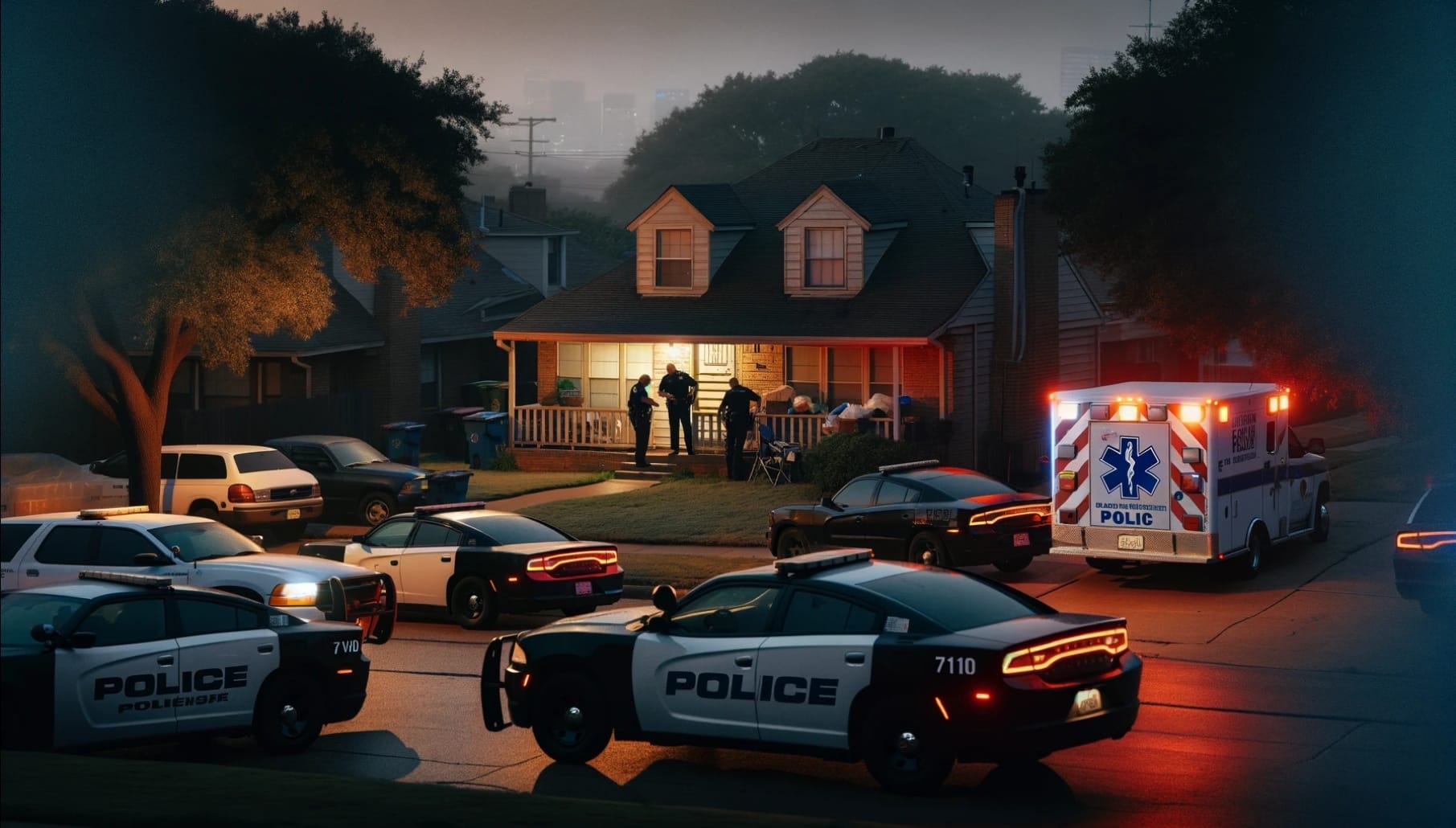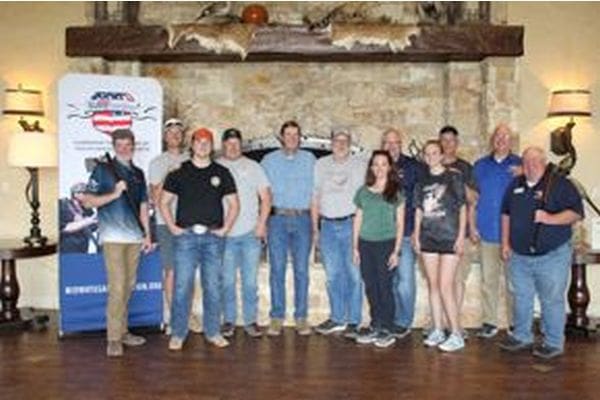We may earn revenue from the products available on this page and participate in affiliate programs. Learn More ›
We live in a great time to be a lumen junky with so many fantastic flashlights on the market. Whether you want a spotlight that fits in the palm of your hand or a feature-rich EDC wonder light, the best flashlight for you is out there. I’ve tested a collection of flashlights over the last year by using them for EDC, around the house, and while hunting and fishing. I also collected beam comparison photos to help you find the right flashlight for your needs. Here are my top flashing picks for different purposes.
How I Tested the Best Flashlights
Beam Comparison
I started my test by comparing the beam patterns of each flashlight. I shined a target from 25 yards to 65 yards to determine each lights effective range. I took a photo of the beam with a camera in manual mode, which you’ll see in each review. I used camera settings that produced photos that looked as close to what I saw with my eyes and the settings remained consistent with each flashlight to give the most accurate comparison possible.
The second beam test was to see how the lights performed with interference from thick brush and from ambient lighting. A flashlight with more candela will allow you to see objects beyond those obstacles, whereas a light lacking the necessary throw will hit pitter out after those obstacles.
Ergonomics and Features
The flashlights I tested are meant to be handheld. Lights in this class need an intuitive button and one that won’t click on accidentally. I tested each flashlight’s ergonomics and features by carrying them and using them daily. Through that process, I found flaws in some pocket clips and found flashlights that I’ll never leave the house without.
The Best Flashlights: Reviews & Recommendations
Best for EDC: Streamlight Wedge
See It
Test Results
- Max Illumination Distance: 45
- Run Time: 3 hours at 300 lumens
- Weight: 3.1 ounces
- Best Use: Daily carry, dog walking, and home
Key Features
- Price: $100
- Lumens: 300 and 1,000 (momentary on only)
- Rechargeable with USB-C
- IPX7 waterproof to 1 meter
- Deep carry clip
Pros
- Excellent beam for EDC tasks
- Ergonomic and simple to use
- Comfortable to carry in a pocket
Cons
- Lacks the customizable settings enthusiasts prefer

Photo by Scott Einsmann
The gear nerd in me loves things like custom user interfaces, LCD screens, and various lumen settings. But, I also like streamlined gear that’s not overly complicated to use. While evaluating EDC lights my pragmatic side won out and I chose the intuitive and simple Streamlight Wedge as the winner.
When you pull the Wedge from your front pocket, your hand naturally falls in the right position to flick the switch on. If the 300 lumens isn’t bright enough for your task, you can push the switch forward for 1,000 lumens. The max brightness setting will jump back to 300 lumens if you let off the switch. The operation is that simple.
In the pocket, the flat and thin Wedge goes unnoticed by the carrier. The deep carry clip keeps the light secure and unobtrusive. In my weeks carrying the Wedge I never had it accidentally turn on in my pocket or felt like it was a burden to carry. I occasionally carried it in my back pocket which was comfortable as well.
The beam is wide, evenly bright, and has a neutral tone. To me, it’s the ideal beam for EDC use. It excels at lighting up a dark parking garage, finding things in a car, and taking a dog for a walk. When using the light at 300 lumens continuously for 30 minutes it was barely warm to the touch, and my laser thermometer read its temperature at 84.5 degrees.
The main cons of the Wedge are that it doesn’t have any hands free capability like a magnet or two-way clip and it lacks features of more technically advanced lights.
Read Next: Best EDC Knives
Best Keychain: Nitecore Tini2 Ti
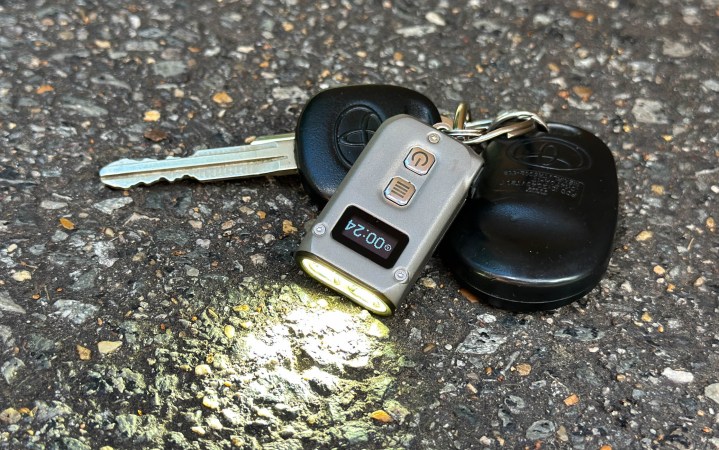
See It
Test Results
- Max Illumination Distance: 40 yards
- Run Time: 45 minutes at 200 lumens
- Weight: 0.8 ounce
- Best Use: Clipped onto a keychain, backpack zipper pull, or dog leash. Excellent as a backup light.
Key Features
- Price: $45
- Lumens: 1, 15, 65, 200, 500
- Candela: 2,000 max
- Titanium
- LCD Display
- Rechargeable with USB-C
Pros
- Easy to carry
- Bright for its size
- LCD screen displays key information
Cons
- Lower battery life than larger options

Photo by Scott Einsmann
An EDC flashlight has to be one that’s easy to carry with you every day. With knives, pens, multi-tools, hanks, phones, and power banks all competing for pocket space, a keychain light like the Tini2 makes for a compelling option. It’s always with you and it doesn’t take up more space than a key fob.
The Tini2’s user interface is simple with a power button that turns the light on and a mode button that cycles through the brightness settings. Hold down the mode button to unleash all 500 lumens. You can set the flashlight into a daily or demo mode. The difference is that the demo mode has an auto shutoff feature.
I used the light on the daily setting, and found the 65 and 200 lumen settings to be the most useful. I like that the LCD screen provides the lumen setting, and the remaining battery life in minutes. The button lock is also handy to keep the light from turning on accidentally.
The beam is surprisingly bright for such a tiny flashlight, and it will leave you wondering why you need a larger light for EDC. It’s all flood and no throw so don’t expect to reach out and illuminate objects beyond 40 yards.
Read Next: Best Power Banks
Best Compact: Olight Baton 3
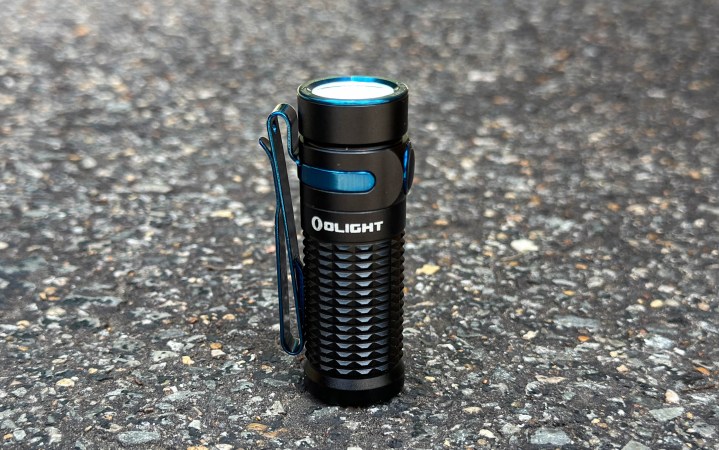
See It
Test Results
- Max Illumination Distance: 60
- Run Time: 1.5 hours at 300 lumens
- Weight: 1.9 ounces
- Best Use: EDC, automotive work, home use
Key Features
- Price: $69
- Lumens: 0.5, 12, 60, 300, 1200
- Wireless, magnetic charger
- Magnet
- Two-way clip
- IPX8 waterproof
Pros
- Small and portable
- Excellent for hands free use
- Ideal as a work light
Cons

Photo by Scott Einsmann
The Baton 3 has the most throw for its lumens of any light I tested. This palm-sized flashlight reached out to 60 yards, and it takes up half the pocket size of similarly bright options. It uses a proprietary magnetic charger, which can be a con if you end up losing the cable. But it means you don’t have a charging port that gets filled with lint or exposed to water.
The magnet and two-way clip allow for hands free use. Whether you’re clipping it to your hat on a hike or sticking it to the hood of your truck while you work.
The on button has a tactical and audible click that’s very difficult to turn on accidentally. The user interface is pretty straightforward. Just press the button for light and hold it to change the brightness setting. A double click will turn on the turbo mode.
Best for Outdoors: Wuben X3
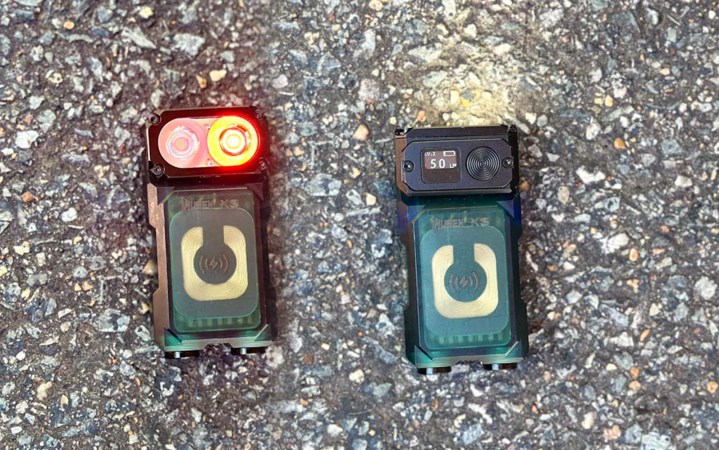
See It
Test results
- Max Illumination Distance: 45 yards
- Run Time: 2 hours at 150 lumens
- Weight: 2.3 ounces
Key Features
- Price: $66
- Lumens: 1, 50, 150, 200, 700
- Wireless charging
- Charger is also a lantern
- Red and white light
- LCD Display
The Wuben X3 is one of the most interesting flashlights available, but it’s not my favorite for carrying in a pocket. Its clip doesn’t work well in a front pocket and its button is too easy to accidentally turn on. But, it’s still an incredible flashlight for certain applications.
The X3 excels at hands free use. The head rotates so you can use it like a standard, inline flashlight or with the light projecting 90 degrees from the body. So you can clip it to a hat or rotate the head and clip it onto a shirt or backpack strap. I utilized that capability and the X3’s red light mode while turkey hunting this spring.
The X3’s charger doubles as a lantern, which is excellent for camping and its long run time means you can actually finish the book you brought.
The user interface is easy to use. A push and hold cycles through settings and a double tap turn on the 700 lumen mode. There’s an LCD screen that lets you know which mode you’re on and the remaining battery life.
Best for Home: Sofirn IF23
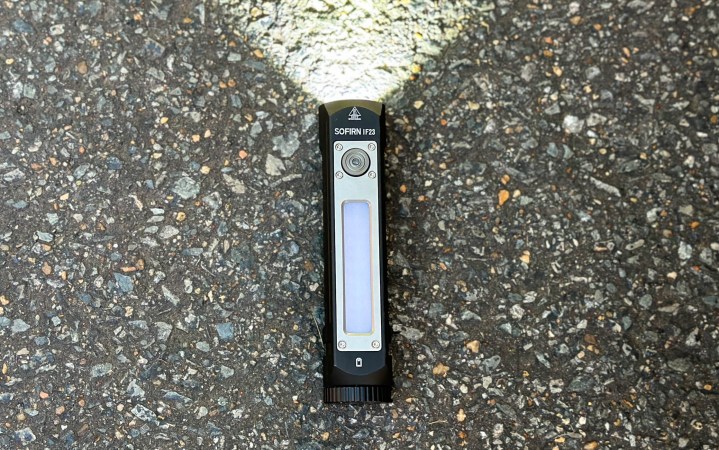
See It
Test results
- Max Illumination Distance: 60 yards
- Run Time: 2 hours at 1,500 lumens
- Weight: 6.5 ounces
Key Features
- Price: $40
- Lumens: 1, 100, 500, 1500, 4000
- 500 lumen lantern
- Magnet
- Can be used as a portable power bank
- Lantern can be changed to red, green, purple, and blue light
- Rechargeable with USB C

Photo by Scott Einsmann
Like the Wuben X3, this light isn’t the most EDC friendly option, but it has a lot of capability. If your EDC gear includes a backpack then I’d consider dropping a Sofrin IF23 into one of the pockets. This light is a lumen beast that shoots out a bright, wide beam. It can turn day into night, but it also has finesse. The 500 lumen lantern mode and magnet make it a capable work light. There’s also a strobe function for emergencies. The colored lights are cool, but have very little practical use.
Best Budget Compact: Thrunite Archer Mini
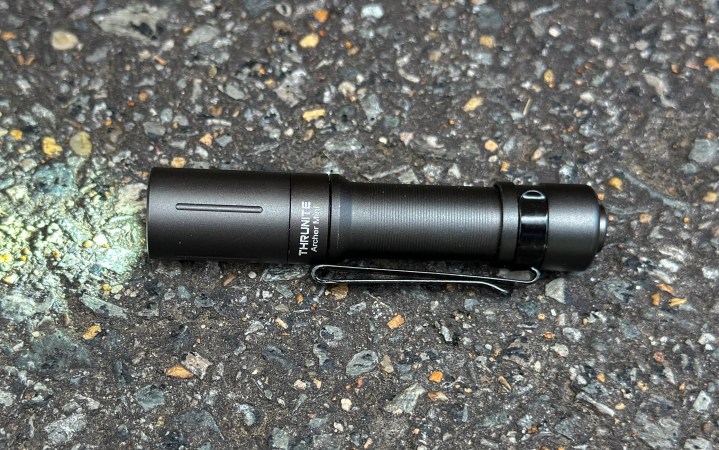
See It
Test Results
- Max Illumination Distance: 50 yards
- Run Time: 50 minutes at 157 lumens
- Weight: 1.3 ounces
Key Features
- Price: $20
- Lumens: 18, 157, 405
- Tail cap click
- Two-way pocket clip
- Rechargeable with USB-C
- IPX8
Pros
- Small and easy to carry
- Good clip
Cons

Photo by Scott Einsmann
The Archer Mini is a classic AAA EDC flashlight. I tested it against several similar models but found its light, button, and user interface unbeatable. It takes up very little pocket space and the pocket clip has the right amount of tension to keep it securely in place. It also fits well in an organizer. I carried the Archer Mini in an Alpaka Zip Pouch Pro and it fit perfectly into the exterior pocket.
The button has a nice tactile click and exclusively has a continuous-on mode. Click it on for the 18 lumens and double click for 405, which will step down to 157 lumens after about 2.5 minutes. There’s a USB-C port hidden in the head of the flashlight for recharging. That means no buying expensive batteries or keeping track of an external charger.
Best Powerful: Nitecore EDC 25

See It
Test Results
- Max Illumination Distance: 65 yards
- Run Time: 1 hour 45 minutes at 1,000 lumens
- Weight: 3.8 ounces
Key Features
- Price: $75
- Lumens: 15, 65, 200, 1000, 3000
- Rechargeable with USB-C
- Battery and lumen indicator
- Button lock
- Flat design
Pros
- Super bright
- Ergonomic
- Locking power button
Cons

Photo by Scott Einsmann
I tested the Nitecore EDC 27, and while I liked it, it had flaws that held it back from being a top pick. Mainly the momentary button jumped from turbo to strobe far too easily. The light also got very hot at its brightest settings.
The new EDC 25 solves many of those problems. It’s far more user friendly and it’s about an ounce lighter. The momentary button puts you at the light’s max output and it will light up a large area with a wide, 3,000 lumen beam. A click and a hold on the power button will turn on the EDC 25’s other settings. One quirk is that you have to press and hold the power button to turn the flashlight off. There are indicator lights on the flashlight that show the light output and battery level.
The flat shape of the EDC 25 is excellent for carry, but about ½ inch of flashlight sticks out of your pocket since it doesn’t use a deep carry clip. The EDC 25 gets hot during continuous use of its high settings. At 1,000 lumens it reached 125 degrees after 12 minutes, and was uncomfortably hot to hold. Even with those cons, the EDC 25 is the best EDC flashlight I’ve tested if you want to carry a super bright flashlight.
Best Budget Powerful: Wurkkos FC13
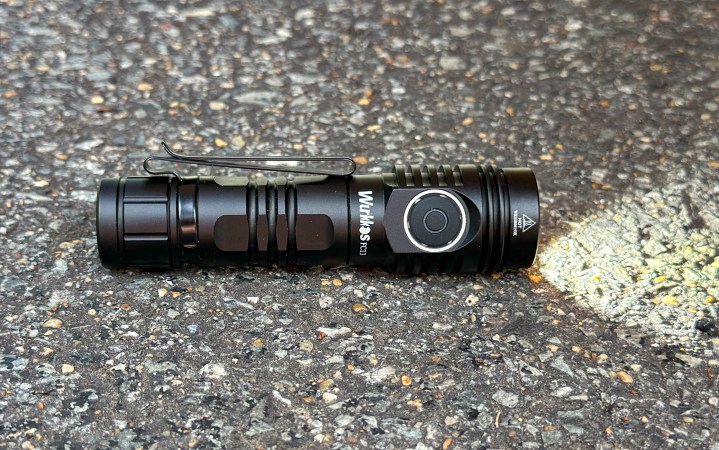
See It
Test Results
- Max Illumination Distance: 50 yards
- Run Time: 2.5 hours at 1080 lumens
- Weight: 4.4 ounces
Key Features
- Price: $34
- Lumens: 0.5, 5, 20, 57, 150, 420, 1080, 3500
- Two way clip
- LCD Display
- Rechargeable with USB-C
- Can be used as a power bank
- Water Resistance: IP68
- Button lights up
Pros
- Bright
- Good balance of throw and flood
- Ergonomically-placed button
Cons

Photo by Scott Einsmann
The Wurkkos FC13 provides the most lumens for your dollar, while also being ergonomic and feature rich. It has eight brightness settings that are easy to navigate with a push and hold of the button — double tap for max brightness. Wurkkos sidestepped the traditional tailcap and went for a button on the flashlight’s head. This makes it ergonomic for EDC tasks.
The beam is well balanced between throw and flood. On the FC13’s brightest setting you can easily illuminate an area that’s 40 yards wide by 40 yards deep. The lower settings are great for up-close tasks or conserving battery life.
Its main cons are its size and weight. It was the heaviest flashlight that made the final cut, and the least pocket friendly. But if you want a bright flashlight that’s packed with great features for under $40, the FC13 is my top choice.
Read Next: Best EDC Multi Tools
Best with a Laser: Olight Arkfeld Pro
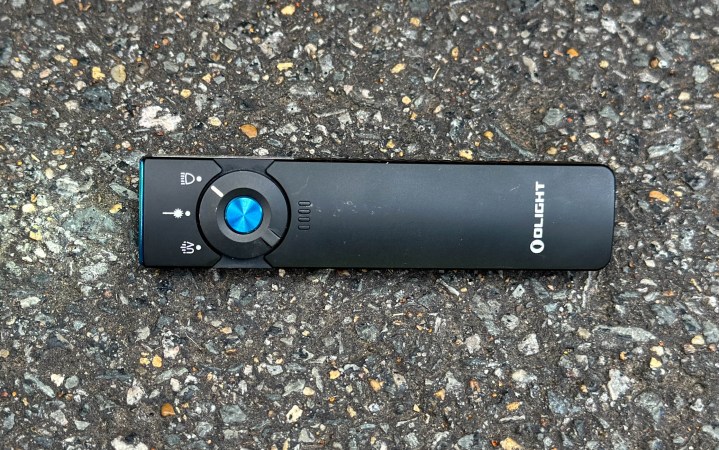
See It
Test Results
- Max Illumination Distance: 45 yards
- Run Time: 2 hours and 6 minutes at 420 lumens
- Weight: 3.9 ounces
Key Features
- Price: $100
- Lumens: 1, 15, 100, 420, 1300
- Two way clip
- Rechargeable with Olight magnetic charger
- Class 3R Laser
- 900 megawatt UV light
- Battery level indicator
Pros
- Easy actuation
- Interesting feature set
Cons
- The laser and UV light are fun, but have limited utility for daily tasks
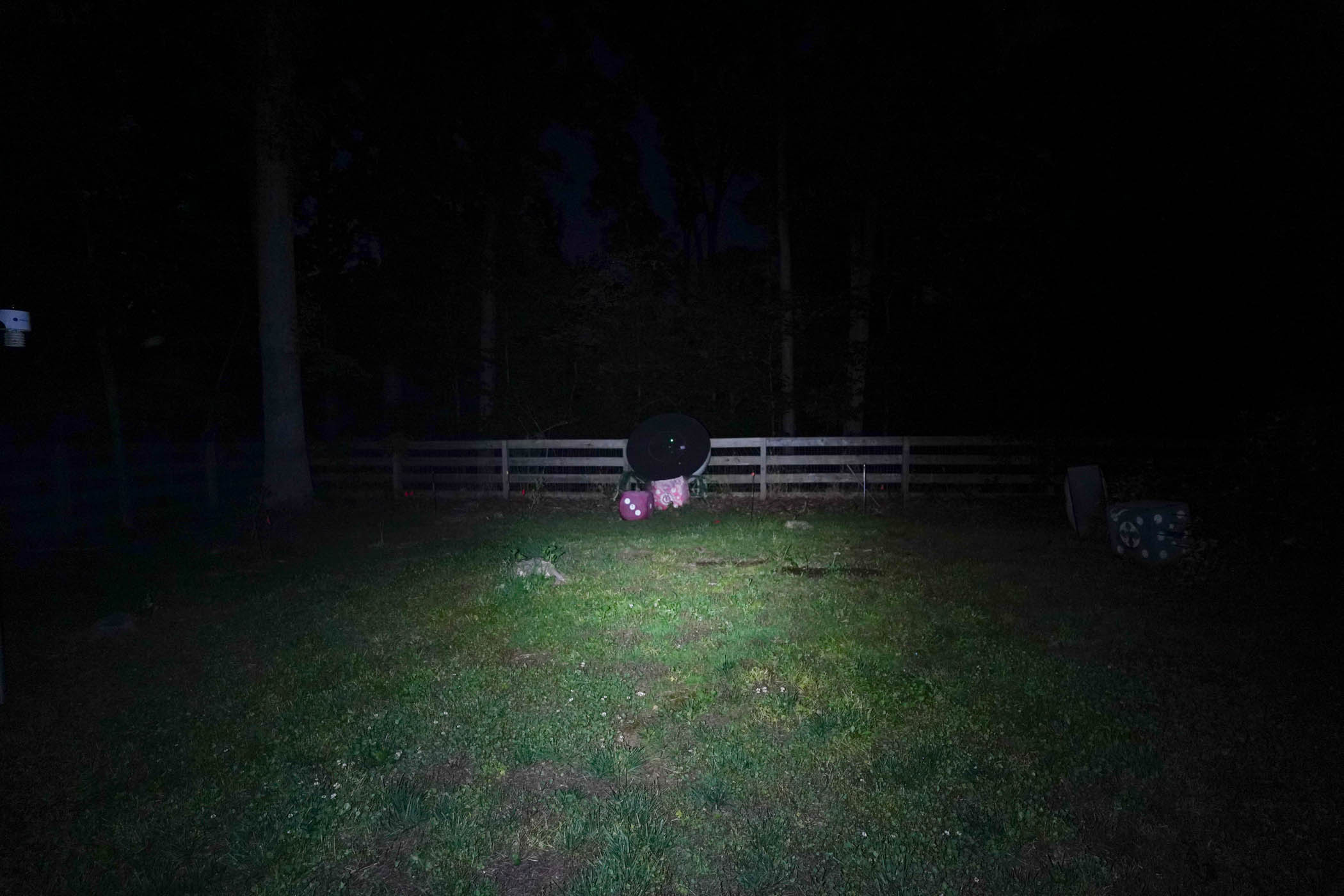
Photo by Scott Einsmann
The Olight Arkfeld Pro is the most fun flashlight I tested, but the features that made it fun also made it one of the least practical. The green laser is powerful and bright. It stretches out well past 100 yards at night and is bright enough to be used indoors during the day. The UV light is great for recharging objects that glow in the dark and seeing things only visible when hit with the UV spectrum. It would have been cool if the Arkfeld Pro had a lower UV spectrum, it’s at 365nm, which is too high to be used for disinfecting objects. A portable UV disinfector would be really handy.
The flashlight portion is excellent with a nice wide, even beam. The user interface is simple and easy to use. You toggle the switch between the different modes and then click the button to turn on. A long hold cycles through brightness levels.
In the pocket the flat Arkfeld Pro is easy to carry and it has a nice deep carry clip. It’s right up there with the Wedge in terms of ease of carry and operation.
Best Tactical: SureFire Stiletto Pro
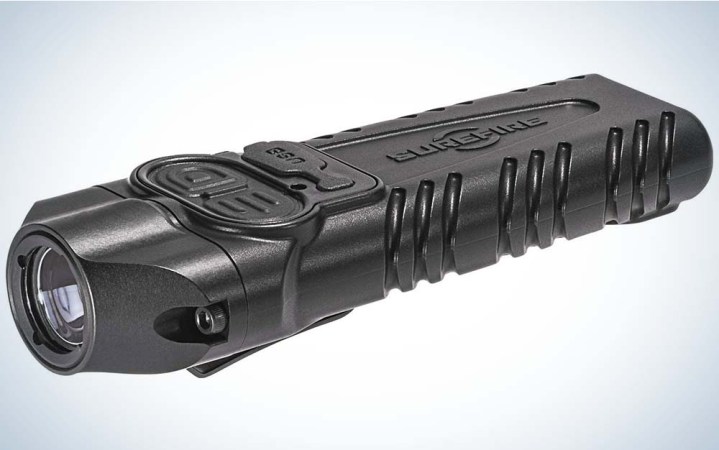
See It
Key Features
- Lumens: 1,000, 300, 25
- Three brightness settings and strobe
- Weight: 4 ounces
- Rechargeable
- Programable
- Passes IPX7 water testing to one meter for 30 minutes
Pros
- Ergonomic
- Long run time
- Slim profile
Cons
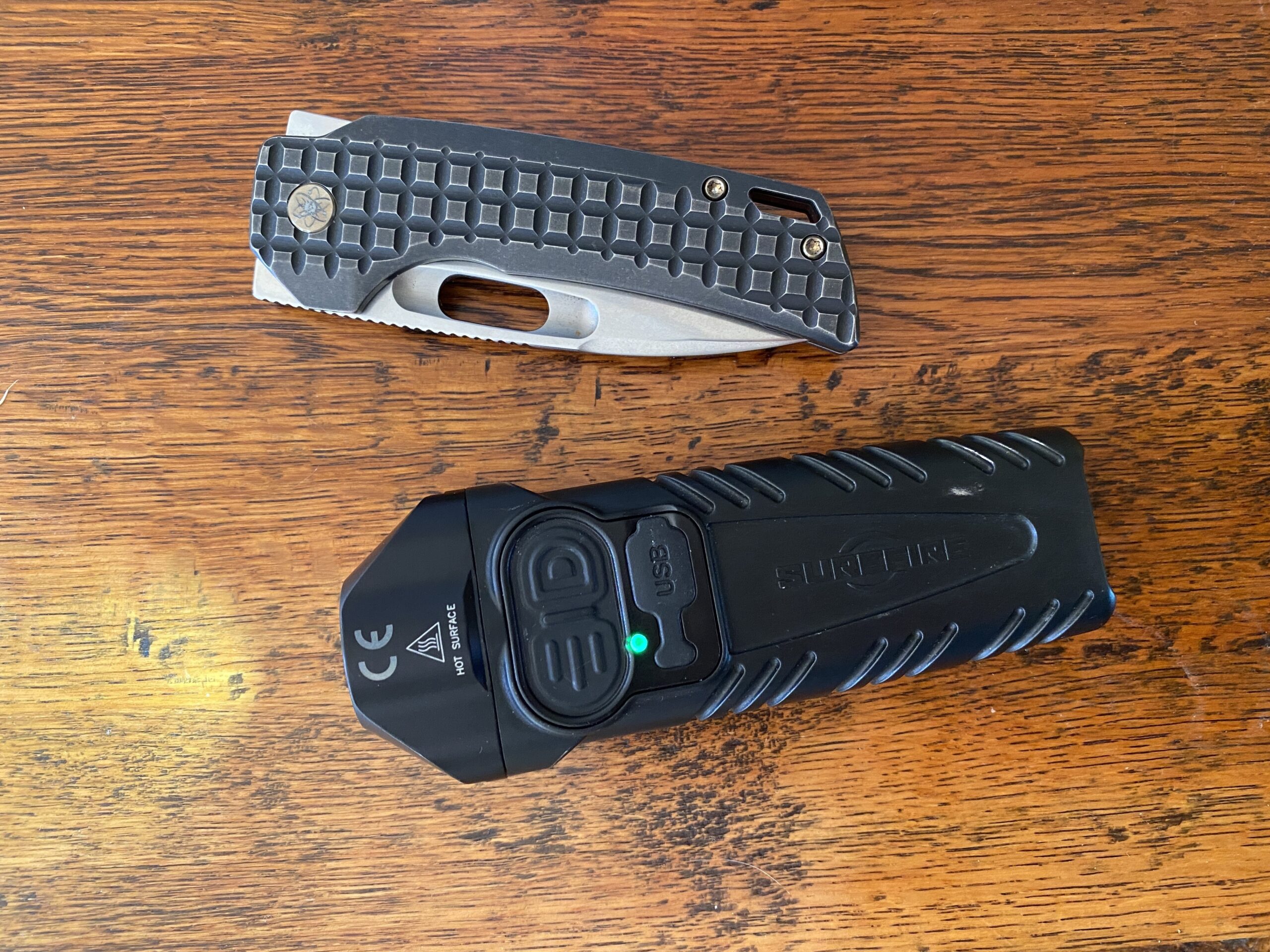
The SureFire Stiletto Pro checks all the boxes for me. It’s easy to carry in a pocket, it’s bright, it has a versatile beam, and it’s rechargeable—all extremely well. The beam pattern is wide and very even edge to edge, which is ideal for EDC applications, blood trailing, and general use.


It has good run time and, at max brightness, you can run it continuously for 1 hour. When the Stiletto Pro is running low, a red indicator light comes on. Recharging the Stiletto Pro is easy with a power bank or plugged into the wall via the micro-USB cable.
The design of the Stiletto Pro is well thought out and extremely ergonomic. It slips into a front pocket and rides unnoticed next to my pocket knife. You hold it a lot like a TV remote and press the on button with your thumb, and you can cycle through the brightness settings by hitting the “on” button like you’re changing channels.
There are tradeoffs for the Stiletto Pro’s nice, even beam. It lacks throw, and you’ll have issues pushing past a photonic barrier or seeing objects beyond 50 yards. But, for most things you’d use a flashlight for, this is the best overall flashlight option.
Best Throw: Modlite PLHv2
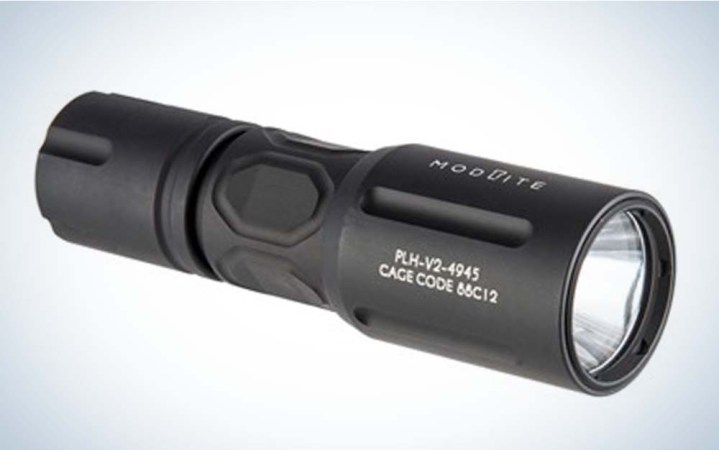
See It
Key Features
- Lumens: 1350
- Weight: 4.5 ounces
- Rechargeable
- Made in the U.S.
Pros
- Throws light far distances
- Extremely bright
- Easy to carry
Cons
- Gets hot after a few minutes of use
- Could be too much light for some situations
- Only one brightness setting
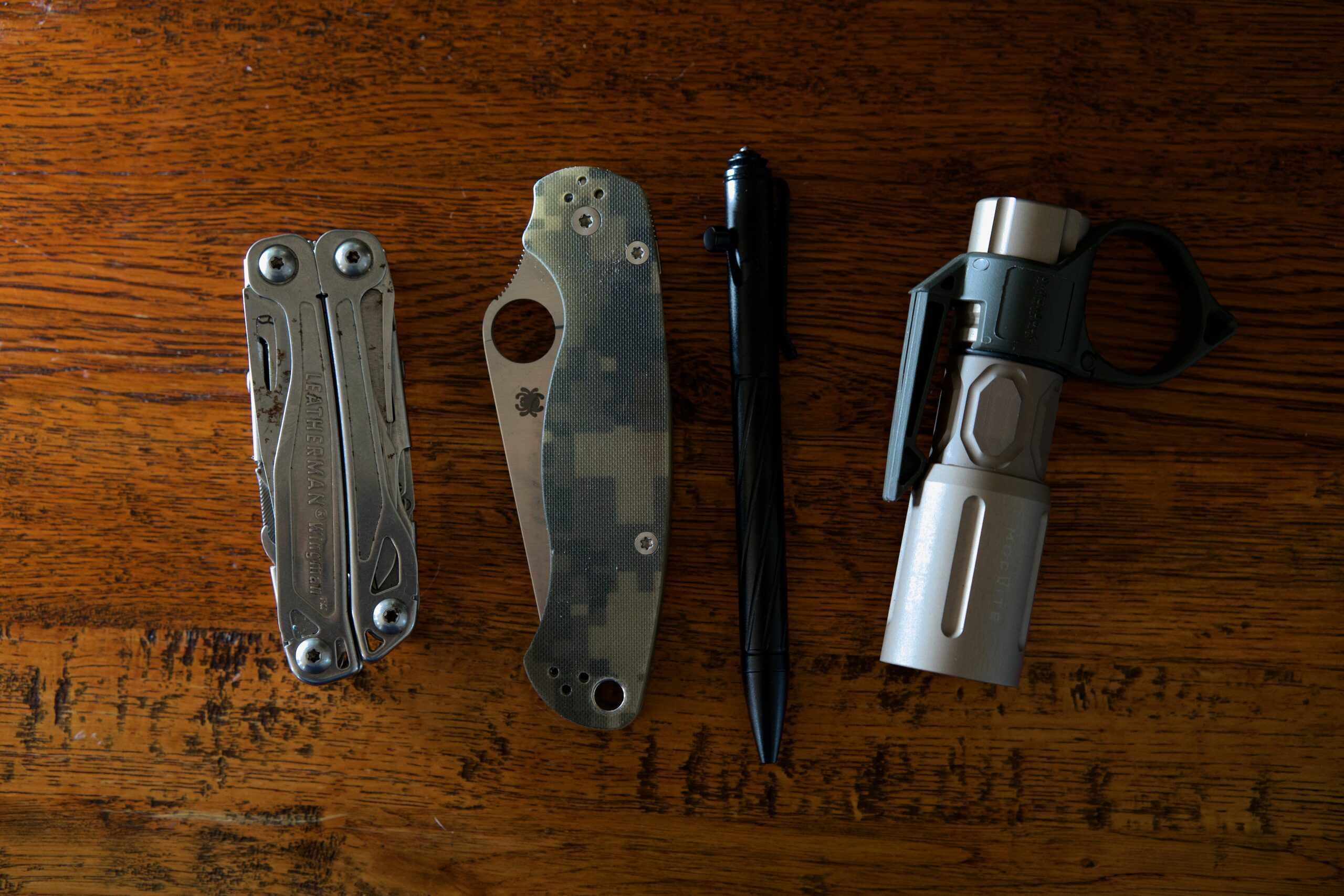
If you want to harness the power of the sun in a pocket-sized flashlight, buy a Modlite. The 1,350 lumens are impressive, but the Modlite PLH‘s 54,000 candela is the real power. That candella means this light can easily spot objects at 100 yards, and in urban environments, you’ll have no trouble pushing past the ambient light to see into dark areas.


The beam has a bright center spot that spills out toward the edges. The intensity of that center spot can’t be overstated, and the crazy thing is that Modlite makes the OKW, which has even more throw. I don’t find the PLH to be too bright for inside use or everyday tasks. Whether I’m using it to look for things in my truck or work my way through a dark house, it performed well. But it isn’t ideal for reading or anything that requires close inspection. While using the PLHv2 for EDC, I found the rechargeable battery lasts about a week.
If you want an impressively bright flashlight that excels in everything but long run time applications, then a Modlite is for you.
Read Next: Best Tactical Flashlights
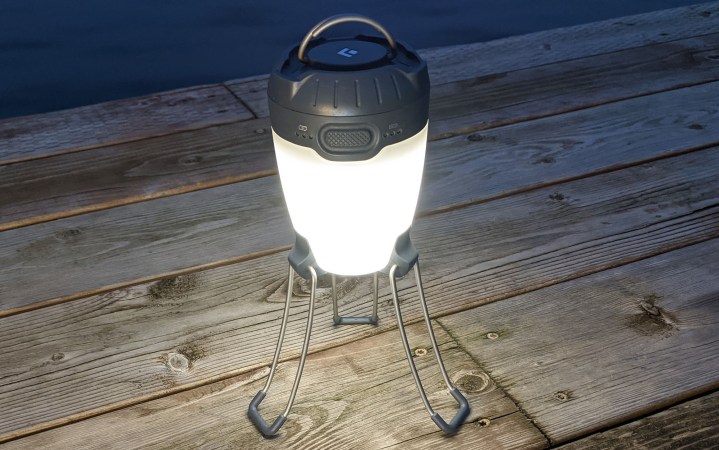
See It
Key Features
- Lasted seven hours at full brightness
- Lumens: 250
- Height: 8.5 inches (unfolded); 4.5 inches (folded)
- Rated for IPX4 (water resistant to heavy rain)
Pros
- Very small packed size
- Light enough to bring on low-key backpacking trips
- Brighter than its lumen-rating would lead you to expect
- Water resistant in case you leave it out overnight
Cons
- White light is less pleasant than other models I looked at
With three foldable legs that extend down to double its body height, the Black Diamond Apollo was one of the most compact camping lanterns I looked at. Despite having the second-lowest lumen rating in my test, the Black Diamond Apollo’s light punched above its weight. Several individuals noted that it seemed as if this lantern was providing at least as much light coverage, if not more, than the higher-lumen LED models.
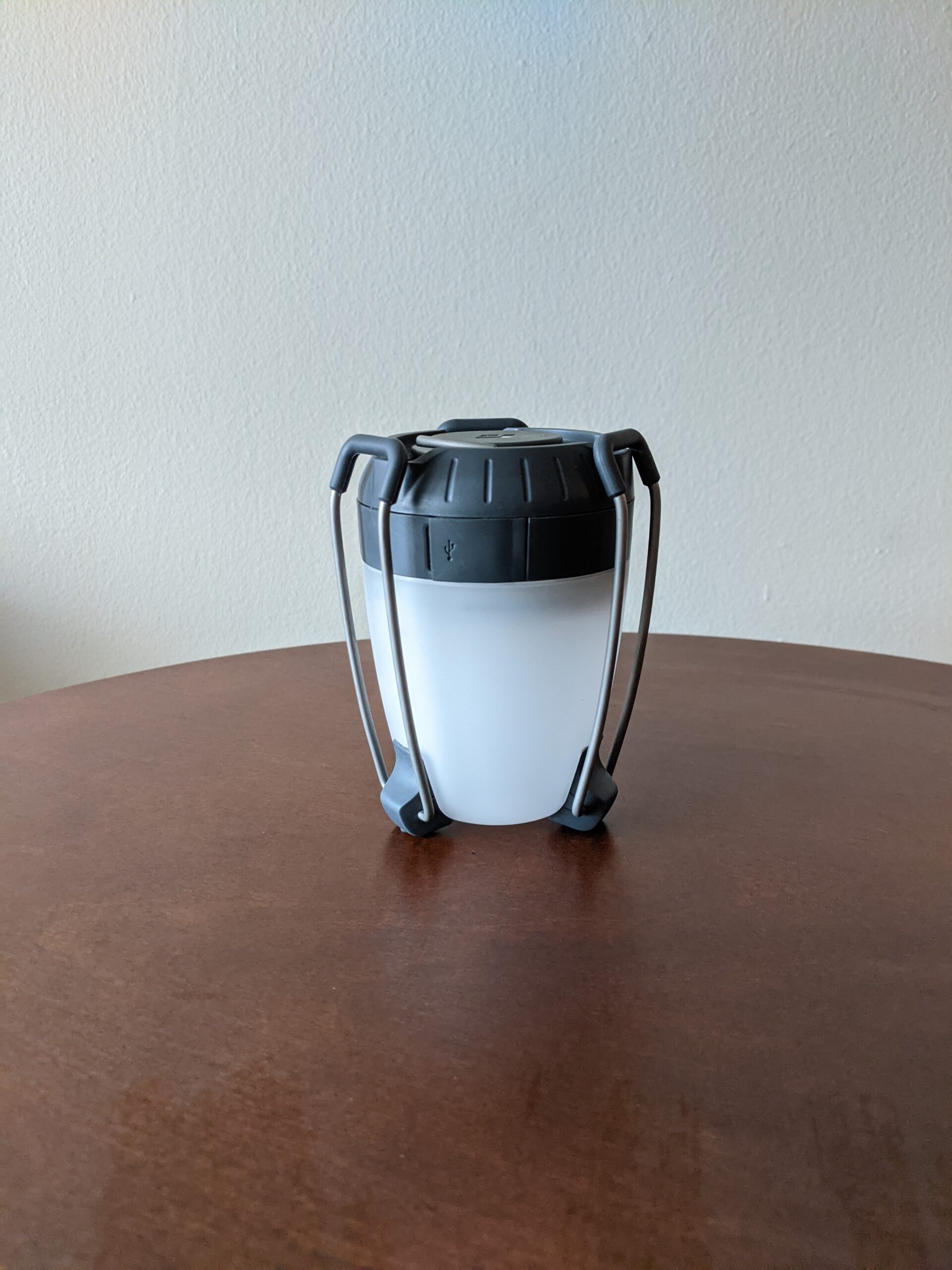
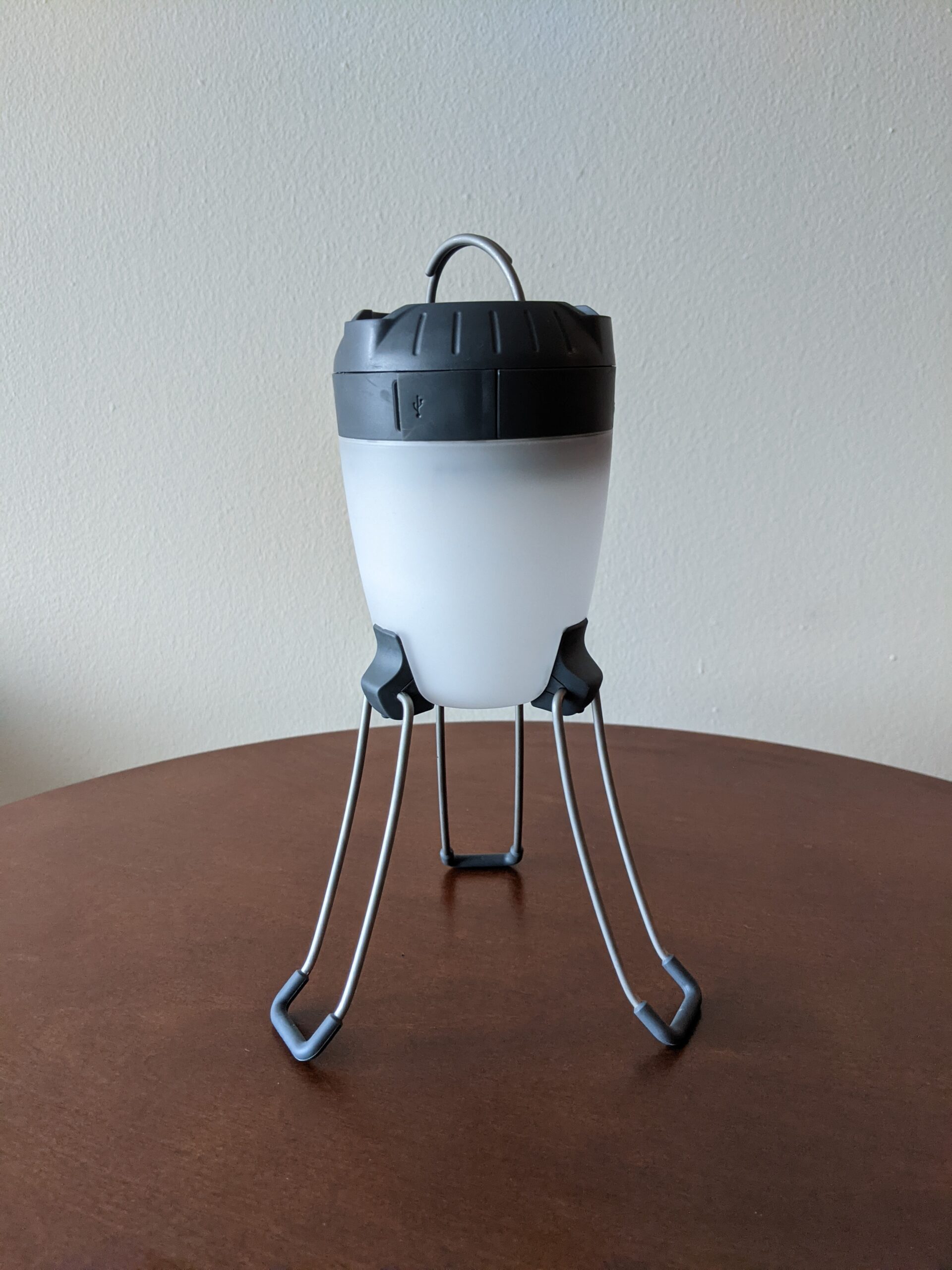
But what really stood out during testing was its battery life. While other batteries only lasted a few hours, this camping lantern was still going seven hours later in warm temperatures, meaning it has enough juice to get you through an evening around the picnic table (its IPX4 rating means it can also handle a little rain). And in the event it does still kick out while the night is young, you still have the option to plug in three AA batteries to keep it going.
While this model does have the option to recharge a secondary device directly from its internal battery (USB connection), it doesn’t quite have a large enough battery to make this a smart choice—bring a battery pack instead.—Laura Lancaster
Read more about the best camping lanterns in our full test article.
How to Choose the Best Flashlight
Flashlights might seem like simple tools, but there’s a lot to consider when you’re choosing the best flashlight. Manufacturers tailor their flashlights for specific purposes, and you’ll want to consider the lumens, candela, size, and power source before selecting the best flashlight for you.
Lumens vs. Candela
Lumens is a measurement for the amount of light a flashlight produces. Candela is a measurement of how much light a flashlight puts out in a specific direction. Let’s say you have two flashlights with the same lumens, but one has a concentrated beam, and the other has a wider beam. The flashlight with the concentrated beam will have more candela.


Size
When you’re looking at a flashlight, you need to think about how you’ll carry it. Will this be a pocket companion, or will it live in a pack, drawer, or center console? The answer to that question will tell you if you want a small, slim light for your pocket or a larger light for off-body carry.
Use
How you’ll use the flashlight is the most important deciding factor. Is this a general-purpose flashlight for walking the dog and making your way through a dark parking lot? Or, is this a duty light that carries a specific need to identify possible threats at distance and blind them? Is this a light you’ll need to run for more than an hour while you blood trail and drag a deer? Choosing the flashlight that best matches your needs will make sure you get years of good use out of it.
Batteries Used in the Best Flashlights
Flashlights can use standard AA or AAA batteries or more exotic power supplies like CR123A batteries. Rechargeable flashlights are also becoming more and more prevalent. My preference leans toward rechargeable flashlights to cut down on waste and cost. Today’s rechargeable batteries also are very powerful, like the ones used in the Modlite. For emergency flashlights, I like standard batteries because they’re what I commonly have around the house. But, CR123A batteries have a great reputation for reliable power in all conditions. You just have to be comfortable with buying a pack specifically for your light.
FAQs
High-output flashlights get hot even if they use an LED. But, LED flashlights below 500 lumens won’t get noticeably hot.
Like all things, you get what you pay for in flashlights. A $300 premium light will have features that budget lights cannot match. But, the real question is, how much performance do you need for your intended use? If you just need a basic light that won’t see hard use, then a $50 to $100 flashlight will serve you very well.
For a micro flashlight, 300 lumens is very good. But, full-size flashlights don’t get exciting until they reach 1,000 lumens with long run times.
EDC stands for u0022everyday carry.u0022 An EDC flashlight is a best-in-class flashlight for a range of different activities that you might expect to encounter over the course of a day.
Final Thoughts on the Best Flashlights
Having the best flashlight for your needs is a huge advantage in the outdoors and everyday life. Whether you go with a tiny powerhouse like the SureFire Sidekick or a lumen monster like the Modlite PLHv2, there’s a great flashlight for your needs out there.
Read the full article here


